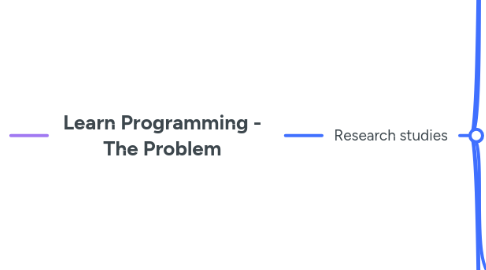
1. Alex's experience
1.1. Information is not presented at the right level of details/abstractions/depth
1.1.1. Possible solution: having concepts presented in multiple levels of details/depths, and automatically showing the "right" level for the student in need
1.2. When someones gets stuck learning a concept, they fail to adapt mostly because adapting in programming is a multi-step process
1.2.1. Possible solutions: -wrong solutions are explored in each problem and thoroughly analysed the shortcomings -creating a generalised process for solving issues (3/4 steps)
1.3. Trying to solve a problem without exposure to the solution/theory greatly helps in problem understanding and in learning the actual good solution
1.3.1. Possible solution: always giving the student the option to try to solve the problem on it's own at the start
1.4. Long-term memory is enhanced by active recall
1.4.1. Solutions: - spaced quizzes on the same concepts - daily open-question that engage with recently learned concepts
1.5. Consistency over intensity
1.5.1. Solution: micro-lessons and celebration/achievements
1.6. Deep understanding over information retention
1.6.1. Solution: -diving deep in the smallest concept -multiple perspective on the same concept -use of analogies
1.7. The perception about success: programming concepts can be understoon on so many levels
1.7.1. Solution: -making students feel comfortable not understanding some concepts - revisiting concepts (spaced learning) - adapting lessons and quizzes to focus on difficult topics specific to a student
1.8. Good understaing of mathematics
1.8.1. Pre-programming course focused on mathemtics and logic
1.9. Developing understanding about the process of learning
1.10. Bringing the parents in the loop
1.11. People with different skills, background and habits but still the same learning experience
2. Research studies
2.1. Reducing withdrawal and failure rates in introductory programming with subgoal labeled worked examples (2020)
2.1.1. Link:https://stemeducationjournal.springeropen.com/articles/10.1186/s40594-020-00222-7#:~:text=Background,regularly%20as%20high%20as%2050%25
2.1.2. "dropout and failure rates in introductory programming courses are regularly as high as 50%"
2.1.3. 265 students inside the study "Learning subgoals consistently improved performance on quizzes, which were formative and given within a week of learning a new procedure, but not on exams, which were summative"
2.2. Comparing the Effectiveness of Online Learning Approaches on CS1 Learning Outcomes (2015)
2.2.1. Link:https://dl.acm.org/doi/epdf/10.1145/2787622.2787709
2.2.2. Using a pretest-posttest study design, we measured the performance of 60 novices before and after they used one of the following, randomly assigned learning activities: 1) complete a Python course on a website called Codecademy, 2) play through and finish a debugging game called Gidget, or 3) use Gidget’s puzzle designer to write programs from scratch
2.2.3. Those completing the Codecademy course and those playing through the Gidget game showed over a 100% increase in correct answers when comparing their post-test exam scores to their pre-test exam scores
2.2.4. Those playing Gidget, however, achieved these same learning gains in half the time.
2.2.5. This was in contrast to novices that used the puzzle designer, who did not show any measurable learning gain
2.3. Dropout Time and Learners’ Performance in Computer Programming MOOCs (Massive Open Online Courses) (2021)
2.3.1. Link:https://files.eric.ed.gov/fulltext/EJ1317808.pdf
2.3.2. The results showed that dropout was highest at the beginning of all studied courses
2.3.3. In longer and more difficult courses, learners mainly dropped out in the week they started due to experiencing problems with the course activities
2.4. Why Do Students Drop Out of Tech Studies? (2020)
2.4.1. Link:https://wawiwa-tech.com/blog/why-do-students-drop-out-of-tech-studies/
2.4.2. Computer Science has the highest dropout rate – 9.8%. Followed by Business studies at 7.4% dropout rate, and then Engineering and Technology degrees closing the top of the dropout chart at a 7.2% dropout rate.
2.4.3. Some students lose motivation and enthusiasm after understanding the hard work needed to complete their tech studies
2.4.4. Students who sign up for Computer Science build on their excitement from computers and technology. They don’t necessarily realize that computer studies include a major mathematics part, for which they lack the proper skills. Math and Logic are important skills for Computer Science and IT courses. If students know the hardships in advance, and verify their skill set matches the requirements, they stand a better chance for completion.
2.4.5. Not knowing how to ask for help: Deborah L. Feldman interviewed more than 50 student dropouts and related to the paralyzing effect of intimidation: “A lot of students said they felt intimidated by their teachers, so in class they didn’t ask questions or say anything about struggles they were having.”
2.5. Undergraduate programming courses, students’ perception and success (2014)\
2.5.1. Link:https://www.sciencedirect.com/science/article/pii/S1877042815011854?ref=pdf_download&fr=RR-2&rr=78771e222df80535
2.5.2. Students lack the understanding of basic programming concepts and algorithms and find programming difficult. Early failure of understanding important concepts weakens students’ confidence and increases drop-out rate.
2.5.3. Students that enroll undergraduate programming courses at the FOS are mostly novices without any programming experience
2.5.4. The first year programming courses are impassable obstacle for many students. Since different researchers hint that mathematical abilities affect programming as we stated above, the correlation analysis was conducted and there is high correlation between students’ success in introductory programming and mathematical courses
2.6. The Fourth Wave of Online Learning: Why Unicorns Udemy, Udacity and Coursera Will Fail, and What Will Replace Them
2.6.1. MCOOs: The proof is in the completion rates: Udemy’s reported completion rate is only 30%, and an average of 70% of students don’t even start the course they enrolled in.
2.6.2. The failure of MCOOs gave rise to: bootcamps and MicroCredentials
2.6.3. The new wave of online education is Cohort-Based NanoCamps. NanoCamp: intensive, high-touch courses, but a breadth of topics, and shorter, catering to upskillers
